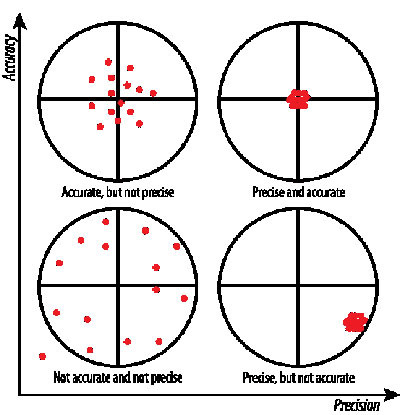Which is preferable: Accuracy or Precision?
View(s):Measurement is essential for us for our daily activities, and we have developed a sense of measurement over a long period of time. The earliest method of measuring was using parts of the human body. The length of a forearm was called a cubit while the foot was the length of a man’s foot. The distance between the ends of outstretched arms was called a fathom. An acre was the amount of land that a team of oxen could plow in one day. A mile was the distance equal to a thousand double paces. We can understand that people had to develop tools to enable them to measure things such as passing of time, dividing land and the amount of grain for exchange purposes.
Although we now have tools for measurement, every measurement contains some uncertainty. This uncertainty is referred to as an error by the scientists. Accuracy and precision are two important terms used with measurements. Both reflect the closeness of a measurement to its real value. Scientists consider a measurement to contain three components.
- The obtained measurement
- The margin of error
- Confidence interval: the probability that the obtained value is within the margin of error.
As an example, a person’s height may be stated as 1.52 metres with a 0.01 m margin of error and 95% level of confidence.
Although both accuracy and precision refer to the quality of measurement, they are different as indicators of measurement. Accuracy can be defined as the closeness of a measured value to a standard or true value. Therefore, accuracy is a measurement of correctness. Accuracy in numbers is usually given by the designated number of decimal places or significant figures. We might say that a height of 1.52 m is correct to 2 decimal places or that it is correct to 3 significant figures.
While accuracy is the degree of closeness to a true value, precision is the degree that it will repeat the same value. In other words, precision is the closeness of two or more measurements to each other. If you measure the height of a tree four times and obtain 2.5 m with every measurement, it has high precision. However, it may not be necessarily accurate depending on the method of measurement. Accuracy can be considered as the degree of veracity and precision is the degree of reproducibility.
Accuracy is more important that precision with numbers. A measurement that is accurate but not precise can still be helpful but a measurement that is precise but inaccurate is not only unhelpful but also can be misleading which may end up with disastrous results. Consider that in an election five people count the number of votes that a candidate received and record them as 24,723, 24,721, 24,723, 24,725 and 24,723. The number of votes may be considered as 24,723 with high precision. However, if there was a box of votes that all of them were not aware of and therefore not counted, the number recorded can be highly inaccurate.
Accuracy and precision are very important in medicine due to concerns of safety. If a drug is not accurate or precise, it cannot be approved for use by the general population. Precision in the medical field shows reliability, consistency or reproducibility. If a patient performs a laboratory test at 4 different labs and obtains the same result, then the result is considered precise.
Carl Wunderlich, a German physician is credited for establishing a measurement for the average body temperature of humans, through a publication of a research report in 1871. He stated that it is 370C as he was working in Celsius. However, Great Britain was using Fahrenheit at that time, and it was converted as 98.60F, in the English translation of the report using the formula F = 9C/5 + 32. There is an issue here about the decimal place. If the original figure was 37.00C, then it would have been reasonable to accept it as 98.60F. But we are not sure whether Wunderlich gave an approximate figure when he stated it as 370C. If so, can we accept 98.60F as an accurate value? Such misleading situations can occur when dealing with accuracy.
Accuracy and precision are both important in surveying too. If a distance 20 metres is measured with the same measuring tape five times and obtains values that agree within 2 millimetres, the measurement can be considered as precise. However, if the measuring tape is short by 10 millimetres, then the measurement is not accurate.
We usually have a lot of faith on precision, sometimes this may be knowingly or unknowingly abused. Consider a claim that 37,437 people attended a carnival. Because of the nature of the stated number, we tend to believe that an exact count has been taken. However, it may be the number of tickets sold and that there were many absences and therefore the actual number was less than 30,000. Similarly, if the reading of the speedometer of a car is taken as 40 mph and converted it as 64.3736 km/h, it is not precise as a reading given to 1 significant figure is converted to a figure with 6 significant figures.
As Arthur David Ritchie quoted “It is really just as bad technique to make a measurement more accurately than is necessary as it is to make it not accurately enough. Therefore, precision is independent of accuracy”.
R.N.A. de Silva
ndesilva@osc.lk
The author is a senior examiner of the International Baccalaureate Organization and an Educational Consultant at the Overseas School of Colombo.
HitAd.lk is the best and biggest mobile phone market in Sri Lanka, and we guarantee you will find what you need here from our extensive listing of mobile phones for sale in Sri Lanka. Whether it’s a budget-priced smartphone for communication, or higher end features with advanced connectivity, there are many different options from which to choose from on our site!


